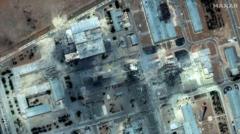Could US Strikes Allow Iran to Reclaim Enriched Uranium?

Understanding the Current Dynamics of Iran's Nuclear Program and Regional Security
The ongoing tension surrounding Iran's nuclear ambitions has captured the attention of global powers, especially in light of recent military actions and intelligence assessments. In June, U.S. forces targeted several Iranian facilities, leading to claims from Israeli officials and the Trump administration that Iran's nuclear program has been significantly hindered. However, the situation is more complex than it appears, as multiple stakeholders provide varying narratives about the effectiveness of these operations and the status of Iran's nuclear capabilities.
The Context of Military Engagements
On June 22, 2023, U.S. forces conducted what has been referred to as "Operation Midnight Hammer," targeting Iranian nuclear sites in Fordo, Natanz, and Isfahan. The operation utilized submarine-launched cruise missiles to strike these facilities, which are pivotal in Iran's uranium enrichment program.
Following the strikes, a senior Israeli official expressed concerns regarding the potential for Iran to recover enriched uranium buried beneath these facilities. Specifically, the official emphasized that while reaching this material would be challenging, any attempts made by Iran would likely provoke further Israeli military action.
Claims of Destruction vs. Reality
Former President Donald Trump and his administration have taken a strong stance, asserting that the strikes “totally obliterated” Iran’s nuclear capabilities. White House spokeswoman Anna Kelly reiterated this narrative, suggesting that the world is now safer because of these decisive actions. However, this statement contrasts sharply with assessments from various U.S. intelligence agencies, which suggest that while the facilities were heavily damaged, they were not entirely destroyed.
The Defense Intelligence Agency’s preliminary report indicates that significant portions of the targeted sites remain operational. CIA Director John Ratcliffe also highlighted the destruction of Iran’s only facility for producing metallic uranium, claiming it was a major setback for Iran's ability to develop nuclear weapons. However, this assertion is tempered by the acknowledgment that other facilities still exist and can potentially be restored.
The Role of International Monitoring
International Atomic Energy Agency (IAEA) Director Rafael Grossi provided a more nuanced perspective, stating that while the facilities were damaged, they were not completely eliminated. This highlights the ongoing complexities of monitoring Iran’s nuclear program, as some parts of the infrastructure continue to be intact and could be operational again with time and resources.
Iran's Position on Nuclear Development
Iran has consistently denied any intentions to develop nuclear weapons, framing its uranium enrichment activities as necessary for peaceful purposes. Iranian officials, including President Mahmoud Pezeshkian, have characterized the aftermath of the U.S. strikes as “severe damage” to their facilities, asserting that access to these sites is currently impossible. This further complicates the situation, as Iran's narrative of peaceful enrichment clashes with Western perceptions of its nuclear ambitions.
The Importance of Intelligence and Evidence
The debate regarding the efficacy of Operation Midnight Hammer and the current state of Iran’s nuclear program largely hinges on intelligence assessments. Israeli officials maintain that much of Iran’s enriched uranium is buried at Isfahan, a claim that underscores the need for vigilant monitoring and intelligence gathering. The assurance from Israeli sources that any attempt by Iran to recover this material would be detected indicates a confidence in their intelligence capabilities.
Potential Implications for Regional Security
The potential for Iran to recover enriched uranium raises significant concerns for regional security. An empowered Iranian nuclear program could lead to a destabilization of the Middle East, prompting neighboring countries to reconsider their own military capabilities and alliances. This is particularly relevant for countries like Saudi Arabia and the United Arab Emirates, which have expressed apprehension about Iran’s nuclear ambitions.
The Future of Diplomatic Efforts
Amidst the backdrop of military action and heightened tensions, diplomatic efforts to address Iran's nuclear program have faced challenges. The dynamic interplay between military action, intelligence assessments, and diplomatic negotiations creates a complex environment that requires careful navigation by all parties involved.
Efforts to revive the Joint Comprehensive Plan of Action (JCPOA), the 2015 agreement aimed at limiting Iran's nuclear capabilities in exchange for sanctions relief, have stalled in recent months. The absence of a diplomatic resolution may lead to a continued cycle of military action and retaliation, further complicating the security landscape in the region.
Regional Reactions and Global Implications
The reactions from various countries to the situation in Iran reflect the broader geopolitical stakes. U.S. allies in the region are closely monitoring developments, and their responses will play a critical role in shaping future actions. The consequences of Iran's nuclear program, whether perceived or real, extend beyond the Middle East, impacting international relations and global security dynamics.
Conclusion: The Path Forward
The situation surrounding Iran's nuclear program is both precarious and multifaceted. With assertions from different stakeholders about the effectiveness of military operations, ongoing intelligence assessments, and Iran's insistence on its peaceful intentions, the path toward resolution remains uncertain. Monitoring and diplomatic engagement are essential to mitigate risks and foster stability in the region.
As the international community grapples with these challenges, the question remains: What steps should be taken to ensure that Iran's nuclear ambitions do not escalate into a broader conflict? The future of regional stability may depend on finding a balanced approach that addresses security concerns while allowing for diplomatic dialogue.
FAQs
What are the main Iranian facilities involved in uranium enrichment?
The primary facilities involved in Iran's uranium enrichment program include Fordo, Natanz, and Isfahan. These sites have been the focus of international scrutiny and military action due to their significance in Iran's nuclear capabilities.
What was Operation Midnight Hammer?
Operation Midnight Hammer was a military operation conducted by U.S. forces on June 22, 2023, targeting Iranian nuclear facilities using submarine-launched cruise missiles. The operation aimed to diminish Iran's nuclear program significantly.
How does the IAEA monitor Iran's nuclear program?
The International Atomic Energy Agency (IAEA) employs a combination of inspections, satellite imagery, and intelligence analysis to monitor Iran's nuclear activities. They assess compliance with international agreements and report on the status of Iran's nuclear facilities.
As the world watches closely, the conversation surrounding Iran's nuclear capabilities continues to evolve. What measures do you believe are necessary to ensure lasting peace in the region? #IranNuclear #MiddleEastSecurity #DiplomacyMatters
Published: 2025-07-11 10:11:04 | Category: world



